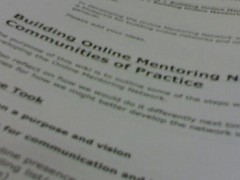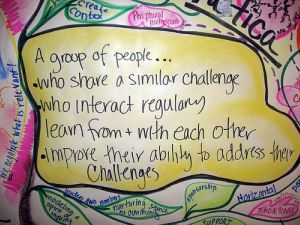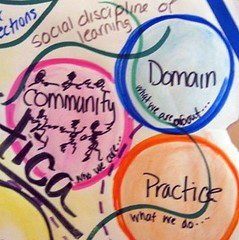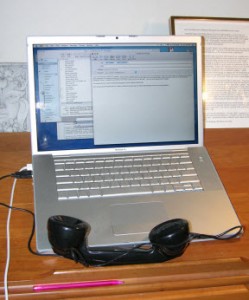I mentioned a while back I was guest blogging on Darren Sidnick’s blog on communities of practice with an emphasis on the current interests of folks at his company, UFI Learndirect. Darren said it was ok to repost these on my blog, so I’ll be including one about once a week for the next 10 weeks. Here is number one, which ran on Darren’s blog in August. Darren Sidnick’s Learning & Technology: Communities of Practice (CoPs) with Nancy White
Part 1, part 2, part 3, part 4, part 5, part 6, part 7 , part 8 , part 9 and part 1o are all here on the blog.
Darren wrote: This is a series of blogs on Communities of Practice (CoP). I’m excited as I’ve teamed up with CoP guru, Nancy White http://fullcirc.com/wp/. Nancy is a regular keynote speaker on the conference circuit and expert practitioner. For me, it’s like getting on the same football pitch with Manchester United’s Ronaldo (or should I say my favourite football player Paul Gascoigne! I’m a Tottenham Hotspurs fan).
Nancy is writing, while I’m editing and doing the odd football/soccer trick (ie. doing a bit of writing). CoP is a hot topic in Ufi learndirect at the moment and an area we are piloting and testing. For me, Communities of Practice take love and attention to get right! They are about people and communities, not about technology or platforms. Anyway, here’s blog 1……………
What is a Community of Practice and Why Should I Care?
You’ve probably heard the term bandied about … “communities of practice” … and in the same breadth someone says “the email list” or the “website.” So what the heck are they talking about and how can a piece of software be a community? Read on…
What is a community of practice?
I like to start with the definition of a community of practice from the guy who coined the term, Etienne Wenger. Here is his definition. Note the last part – that is the important part:
Communities of practice are formed by people who engage in a process of collective learning in a shared domain of human endeavor: a tribe learning to survive, a band of artists seeking new forms of expression, a group of engineers working on similar problems, a clique of pupils defining their identity in the school, a network of surgeons exploring novel techniques, a gathering of first-time managers helping each other cope. In a nutshell:
Communities of practice are groups of people who share a concern or a passion for something they do and learn how to do it better as they interact regularly.
There are three important things in this definition: groups of people (community), domain (a passion for something) and practice (do it better as they interact regularly.) CoPs are not one shot deals that happen at meetings or conferences. They grow and develop over time. In subsequent posts, we’ll talk more about community, domain and practice – because they can be really useful terms as we think about launching and sustaining communities of practice. (CoP).
How are CoPs useful in learning?
But first lets get practical and think about the role of CoPs in eLearning. How can CoPs enhance learning?
- They offer the chance to making meaning of our learning as we apply it to our lives/work/tasks. When we learn something in a course, it can go in one ear and out the other. You know the old adage of the power of application. Even more powerful is how much we learn when we have to teach someone else. So the sharing of the application – what is working or not working, asking for help and teaching others what we know – makes our learning in a community of practice deeper and longer lasting.
- They connect us with people who can be resources for continued learning, opportunities for practice or even job leads. Communities can offer people access to networks which are particularly important if their learning is to support employment.
- They allow us all to use our expertise. The “teacher” or the course content may be the initial source of learning, but the learners themselves can be great sources of knowledge. Communities of practice may create things that capture and share their learning. They may bring in local context that deepens the learning. Together we know more than any one of us alone.
Wait a minute!

So does that mean you should rush out and start a CoP? It all depends… We need to ask ourselves a few questions before we go “launching a community” because CoPs are not always what we need. And that’s ok. So here we go:
- The value to participants. Is there a group of people who want to and will interact and learn together over time? If not, maybe there is another form we should be looking at, such as a network. Or a site where people can go for related content. Communities have to be of enough value so people will take the time and effort to participate.
- Time and access. Do these people have the time and access to interact, particularly online since we are talking about an e-learning context? Are they already meeting face to face – and if yes, do you even need the added online layer? If not, don’t bother!
- Is there an existing CoP that fills the need? If yes, think hard before you try and create a new community. It is easier to build on what exists than to start from scratch AND compete for attention.
- Support. If there is a group of people who want to learn together over time, is there sufficient conditions to nurture the community such as leadership and facilitation? Online CoPs , we’ve learned, really benefit from facilitation. Is that in the plan and the budget? If not, think twice.
The tool is not the community
If you still think a CoP is useful for your context, let’s clear up one more issue. Web based tools, sometimes called “Web 2.0” tools allow us to “be together” as a community even if we are not in the same location. The internet has radically reshaped what a CoP can be. But it is VERY IMPORTANT not to confuse the community with the platform. Communities are made up of people. Platforms support their interactions. Just because you provide a platform does NOT mean you will auto-magically have a community. But these tools will allow you to support people connecting across distance, allowing a greater diversity of thought which can enrich a community. They allow communities to share what they know and connect to other communities and the world, which can deepen their learning. So technology has become an important part of the community toolkit.
If you are already using CoPs for yourself or for your learners, leave a comment here and tell a story or share a URL … how is it working for you?
Want to know more about Communities of Practice? Here are some great resources:

 We are into our second week of the
We are into our second week of the 



 I have a tendency to destroy my computer headsets/mics with regularity. I run over the cords, the plugs loosen and then the sound degrades. It is time again to buy a new set, but instead of buying the cheapest set at the local office store, I decided to get the recommendations of my network – since many are also frequent users of this product.
I have a tendency to destroy my computer headsets/mics with regularity. I run over the cords, the plugs loosen and then the sound degrades. It is time again to buy a new set, but instead of buying the cheapest set at the local office store, I decided to get the recommendations of my network – since many are also frequent users of this product.